Financial Audit and Assurance: Analysis of Trunkey Creek Wines Ltd
VerifiedAdded on 2023/06/07
|21
|5541
|439
Report
AI Summary
This report provides a financial analysis of Trunkey Creek Wines Limited (TCW), focusing on audit risk assessment and key financial ratios. It identifies potential material misstatements in TCW's financial statements, analyzes accounts receivables, investments, property assets, and marketing expenses, and suggests audit steps to mitigate these risks. The report also evaluates business risks by examining financial ratios such as return on equity, return on assets from beef and wine production, gross margin, marketing expenditure over selling and administrative expenses, times interest earned, and days in inventory. The analysis includes a comparison of financial data from 2016 and 2017, along with unaudited estimates for 2018, to provide a comprehensive overview of TCW's financial health and performance.
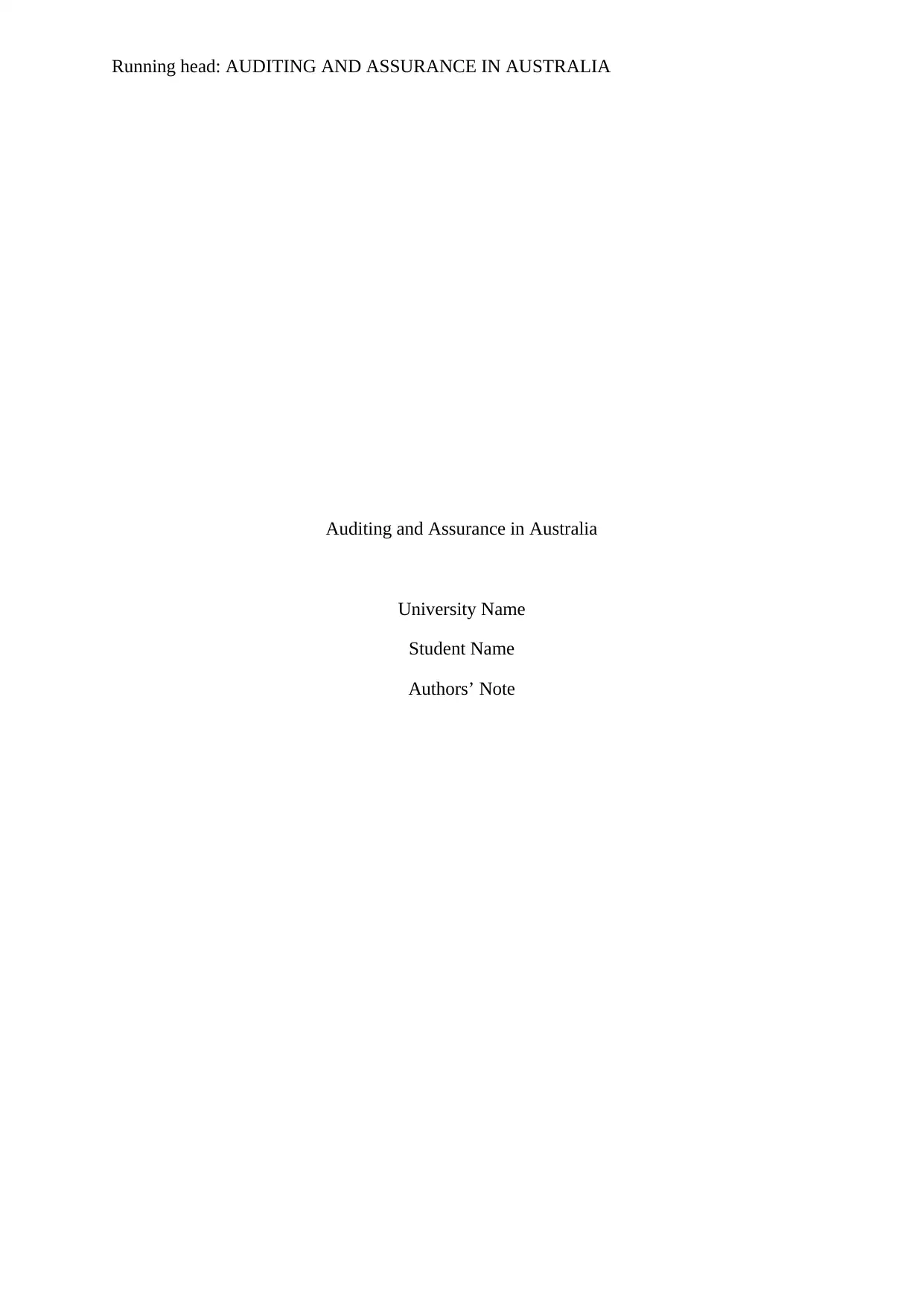
Running head: AUDITING AND ASSURANCE IN AUSTRALIA
Auditing and Assurance in Australia
University Name
Student Name
Authors’ Note
Auditing and Assurance in Australia
University Name
Student Name
Authors’ Note
Paraphrase This Document
Need a fresh take? Get an instant paraphrase of this document with our AI Paraphraser
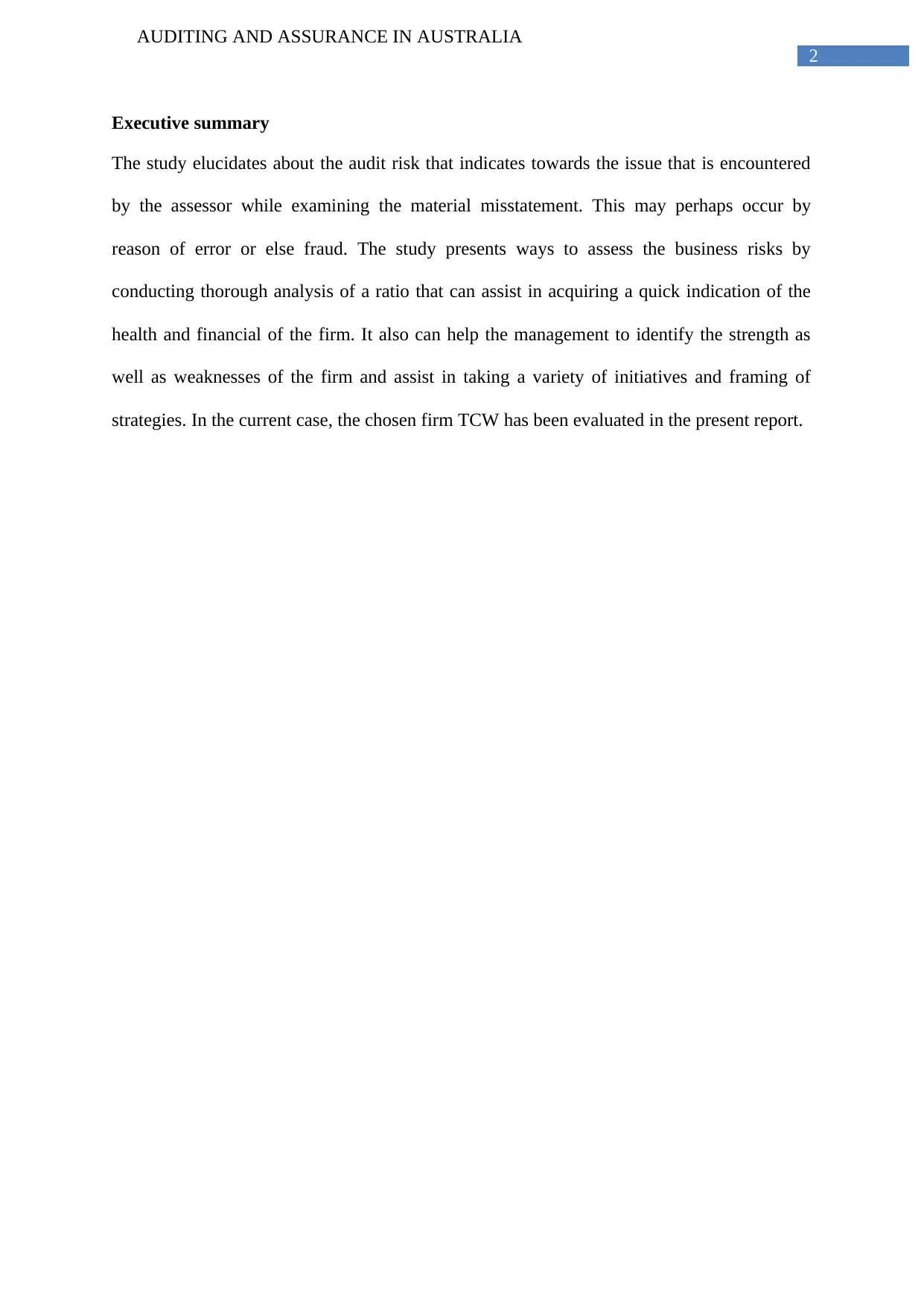
2
AUDITING AND ASSURANCE IN AUSTRALIA
Executive summary
The study elucidates about the audit risk that indicates towards the issue that is encountered
by the assessor while examining the material misstatement. This may perhaps occur by
reason of error or else fraud. The study presents ways to assess the business risks by
conducting thorough analysis of a ratio that can assist in acquiring a quick indication of the
health and financial of the firm. It also can help the management to identify the strength as
well as weaknesses of the firm and assist in taking a variety of initiatives and framing of
strategies. In the current case, the chosen firm TCW has been evaluated in the present report.
AUDITING AND ASSURANCE IN AUSTRALIA
Executive summary
The study elucidates about the audit risk that indicates towards the issue that is encountered
by the assessor while examining the material misstatement. This may perhaps occur by
reason of error or else fraud. The study presents ways to assess the business risks by
conducting thorough analysis of a ratio that can assist in acquiring a quick indication of the
health and financial of the firm. It also can help the management to identify the strength as
well as weaknesses of the firm and assist in taking a variety of initiatives and framing of
strategies. In the current case, the chosen firm TCW has been evaluated in the present report.
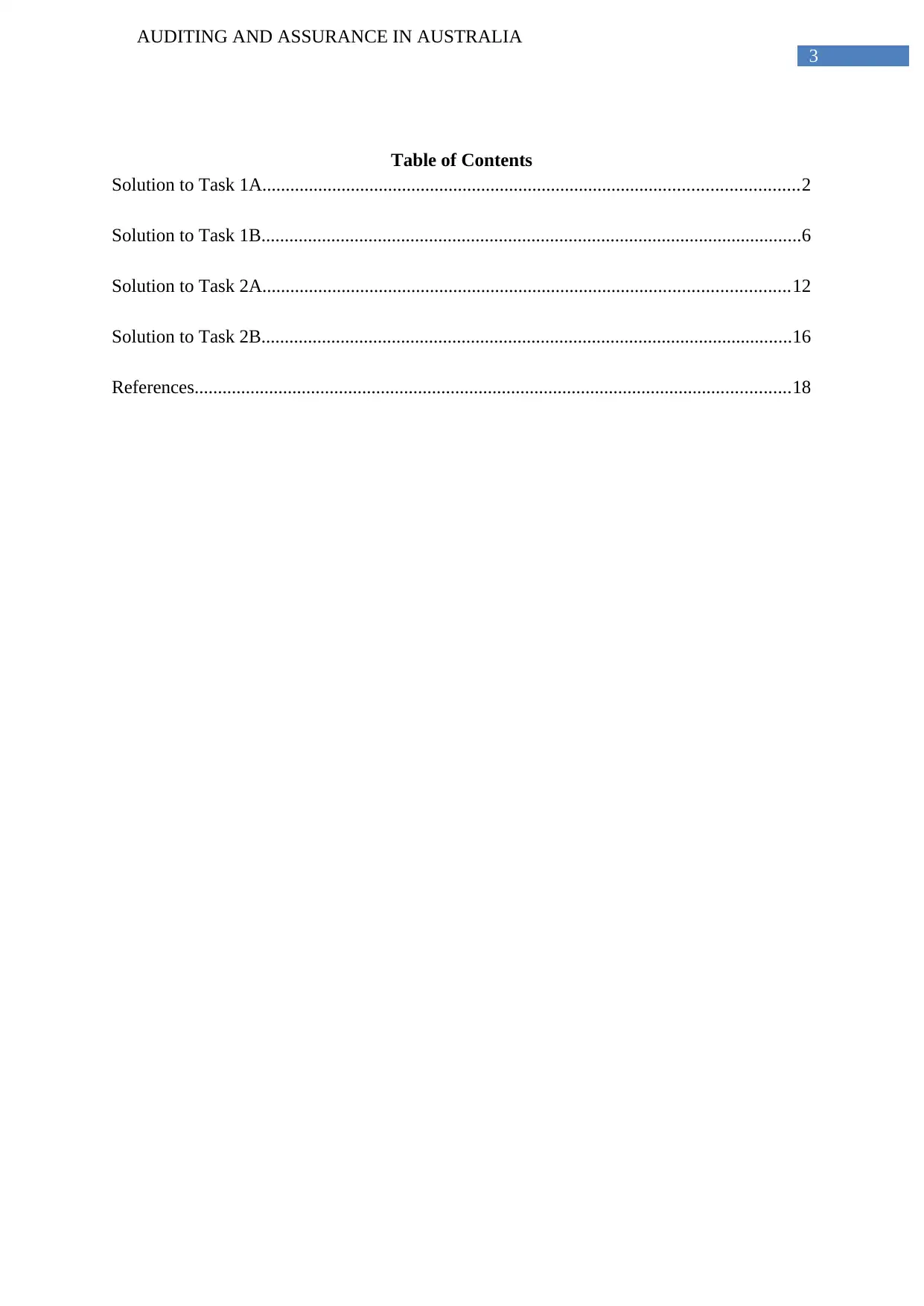
3
AUDITING AND ASSURANCE IN AUSTRALIA
Table of Contents
Solution to Task 1A...................................................................................................................2
Solution to Task 1B....................................................................................................................6
Solution to Task 2A.................................................................................................................12
Solution to Task 2B..................................................................................................................16
References................................................................................................................................18
AUDITING AND ASSURANCE IN AUSTRALIA
Table of Contents
Solution to Task 1A...................................................................................................................2
Solution to Task 1B....................................................................................................................6
Solution to Task 2A.................................................................................................................12
Solution to Task 2B..................................................................................................................16
References................................................................................................................................18
⊘ This is a preview!⊘
Do you want full access?
Subscribe today to unlock all pages.

Trusted by 1+ million students worldwide
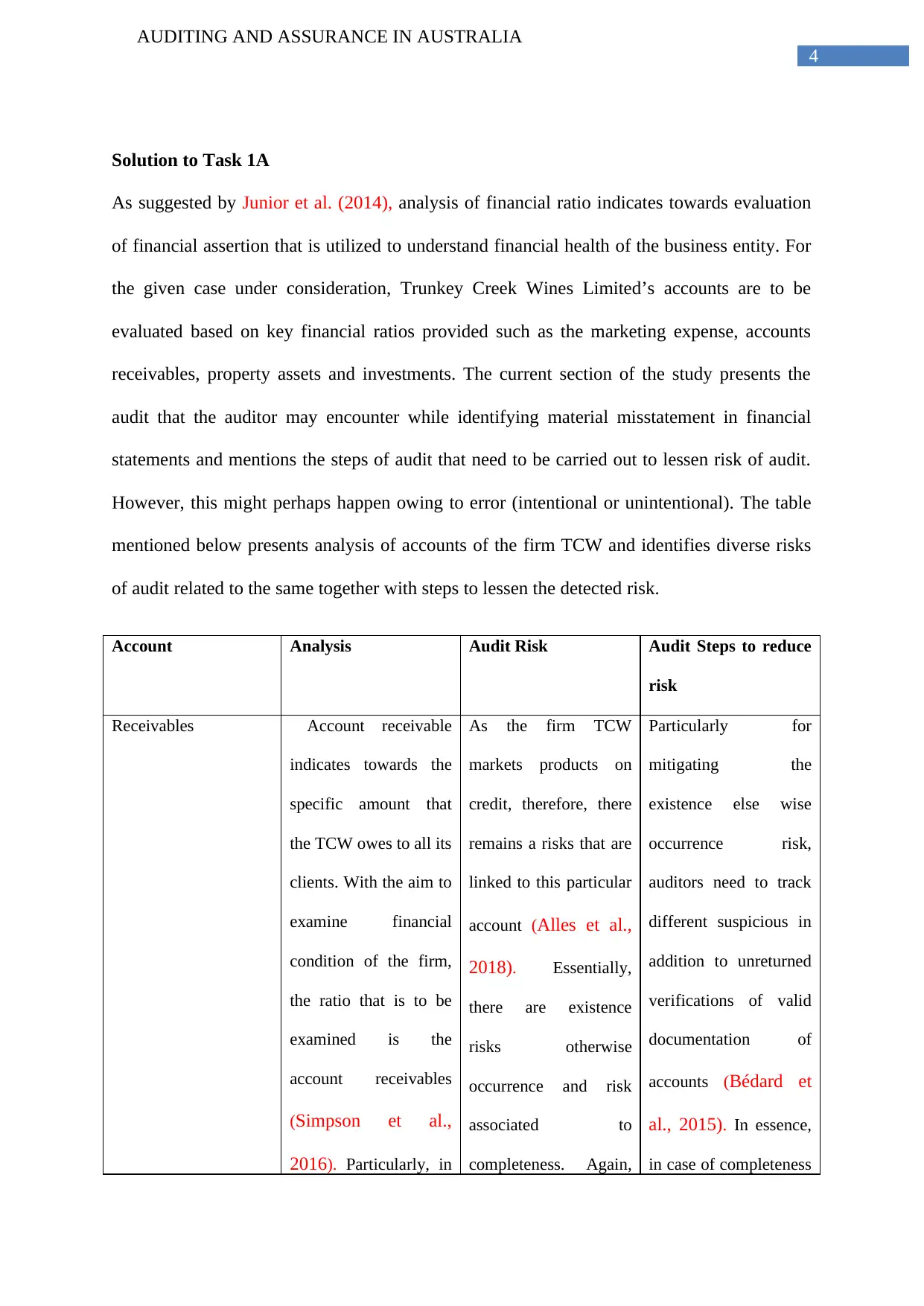
4
AUDITING AND ASSURANCE IN AUSTRALIA
Solution to Task 1A
As suggested by Junior et al. (2014), analysis of financial ratio indicates towards evaluation
of financial assertion that is utilized to understand financial health of the business entity. For
the given case under consideration, Trunkey Creek Wines Limited’s accounts are to be
evaluated based on key financial ratios provided such as the marketing expense, accounts
receivables, property assets and investments. The current section of the study presents the
audit that the auditor may encounter while identifying material misstatement in financial
statements and mentions the steps of audit that need to be carried out to lessen risk of audit.
However, this might perhaps happen owing to error (intentional or unintentional). The table
mentioned below presents analysis of accounts of the firm TCW and identifies diverse risks
of audit related to the same together with steps to lessen the detected risk.
Account Analysis Audit Risk Audit Steps to reduce
risk
Receivables Account receivable
indicates towards the
specific amount that
the TCW owes to all its
clients. With the aim to
examine financial
condition of the firm,
the ratio that is to be
examined is the
account receivables
(Simpson et al.,
2016). Particularly, in
As the firm TCW
markets products on
credit, therefore, there
remains a risks that are
linked to this particular
account (Alles et al.,
2018). Essentially,
there are existence
risks otherwise
occurrence and risk
associated to
completeness. Again,
Particularly for
mitigating the
existence else wise
occurrence risk,
auditors need to track
different suspicious in
addition to unreturned
verifications of valid
documentation of
accounts (Bédard et
al., 2015). In essence,
in case of completeness
AUDITING AND ASSURANCE IN AUSTRALIA
Solution to Task 1A
As suggested by Junior et al. (2014), analysis of financial ratio indicates towards evaluation
of financial assertion that is utilized to understand financial health of the business entity. For
the given case under consideration, Trunkey Creek Wines Limited’s accounts are to be
evaluated based on key financial ratios provided such as the marketing expense, accounts
receivables, property assets and investments. The current section of the study presents the
audit that the auditor may encounter while identifying material misstatement in financial
statements and mentions the steps of audit that need to be carried out to lessen risk of audit.
However, this might perhaps happen owing to error (intentional or unintentional). The table
mentioned below presents analysis of accounts of the firm TCW and identifies diverse risks
of audit related to the same together with steps to lessen the detected risk.
Account Analysis Audit Risk Audit Steps to reduce
risk
Receivables Account receivable
indicates towards the
specific amount that
the TCW owes to all its
clients. With the aim to
examine financial
condition of the firm,
the ratio that is to be
examined is the
account receivables
(Simpson et al.,
2016). Particularly, in
As the firm TCW
markets products on
credit, therefore, there
remains a risks that are
linked to this particular
account (Alles et al.,
2018). Essentially,
there are existence
risks otherwise
occurrence and risk
associated to
completeness. Again,
Particularly for
mitigating the
existence else wise
occurrence risk,
auditors need to track
different suspicious in
addition to unreturned
verifications of valid
documentation of
accounts (Bédard et
al., 2015). In essence,
in case of completeness
Paraphrase This Document
Need a fresh take? Get an instant paraphrase of this document with our AI Paraphraser
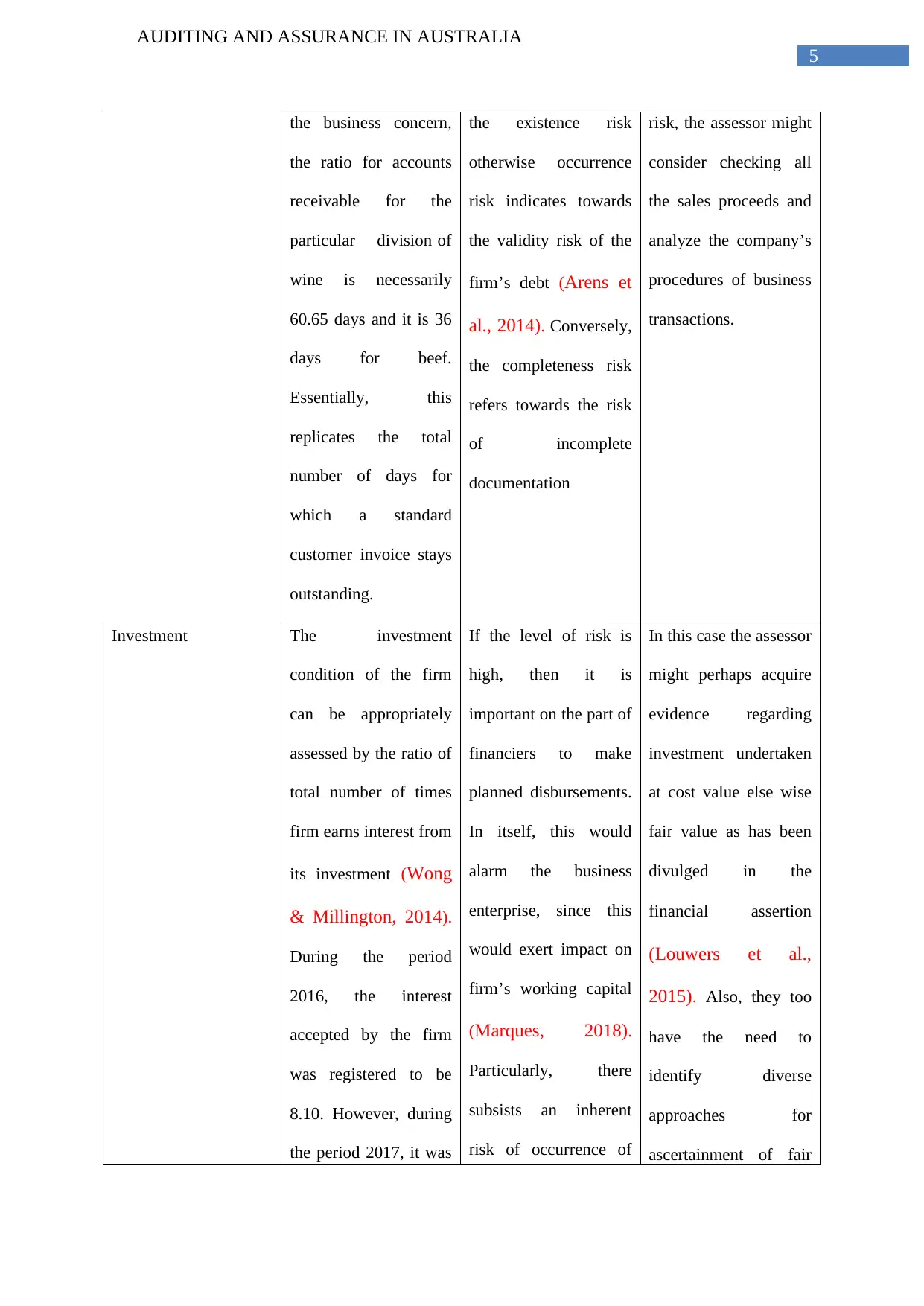
5
AUDITING AND ASSURANCE IN AUSTRALIA
the business concern,
the ratio for accounts
receivable for the
particular division of
wine is necessarily
60.65 days and it is 36
days for beef.
Essentially, this
replicates the total
number of days for
which a standard
customer invoice stays
outstanding.
the existence risk
otherwise occurrence
risk indicates towards
the validity risk of the
firm’s debt (Arens et
al., 2014). Conversely,
the completeness risk
refers towards the risk
of incomplete
documentation
risk, the assessor might
consider checking all
the sales proceeds and
analyze the company’s
procedures of business
transactions.
Investment The investment
condition of the firm
can be appropriately
assessed by the ratio of
total number of times
firm earns interest from
its investment (Wong
& Millington, 2014).
During the period
2016, the interest
accepted by the firm
was registered to be
8.10. However, during
the period 2017, it was
If the level of risk is
high, then it is
important on the part of
financiers to make
planned disbursements.
In itself, this would
alarm the business
enterprise, since this
would exert impact on
firm’s working capital
(Marques, 2018).
Particularly, there
subsists an inherent
risk of occurrence of
In this case the assessor
might perhaps acquire
evidence regarding
investment undertaken
at cost value else wise
fair value as has been
divulged in the
financial assertion
(Louwers et al.,
2015). Also, they too
have the need to
identify diverse
approaches for
ascertainment of fair
AUDITING AND ASSURANCE IN AUSTRALIA
the business concern,
the ratio for accounts
receivable for the
particular division of
wine is necessarily
60.65 days and it is 36
days for beef.
Essentially, this
replicates the total
number of days for
which a standard
customer invoice stays
outstanding.
the existence risk
otherwise occurrence
risk indicates towards
the validity risk of the
firm’s debt (Arens et
al., 2014). Conversely,
the completeness risk
refers towards the risk
of incomplete
documentation
risk, the assessor might
consider checking all
the sales proceeds and
analyze the company’s
procedures of business
transactions.
Investment The investment
condition of the firm
can be appropriately
assessed by the ratio of
total number of times
firm earns interest from
its investment (Wong
& Millington, 2014).
During the period
2016, the interest
accepted by the firm
was registered to be
8.10. However, during
the period 2017, it was
If the level of risk is
high, then it is
important on the part of
financiers to make
planned disbursements.
In itself, this would
alarm the business
enterprise, since this
would exert impact on
firm’s working capital
(Marques, 2018).
Particularly, there
subsists an inherent
risk of occurrence of
In this case the assessor
might perhaps acquire
evidence regarding
investment undertaken
at cost value else wise
fair value as has been
divulged in the
financial assertion
(Louwers et al.,
2015). Also, they too
have the need to
identify diverse
approaches for
ascertainment of fair
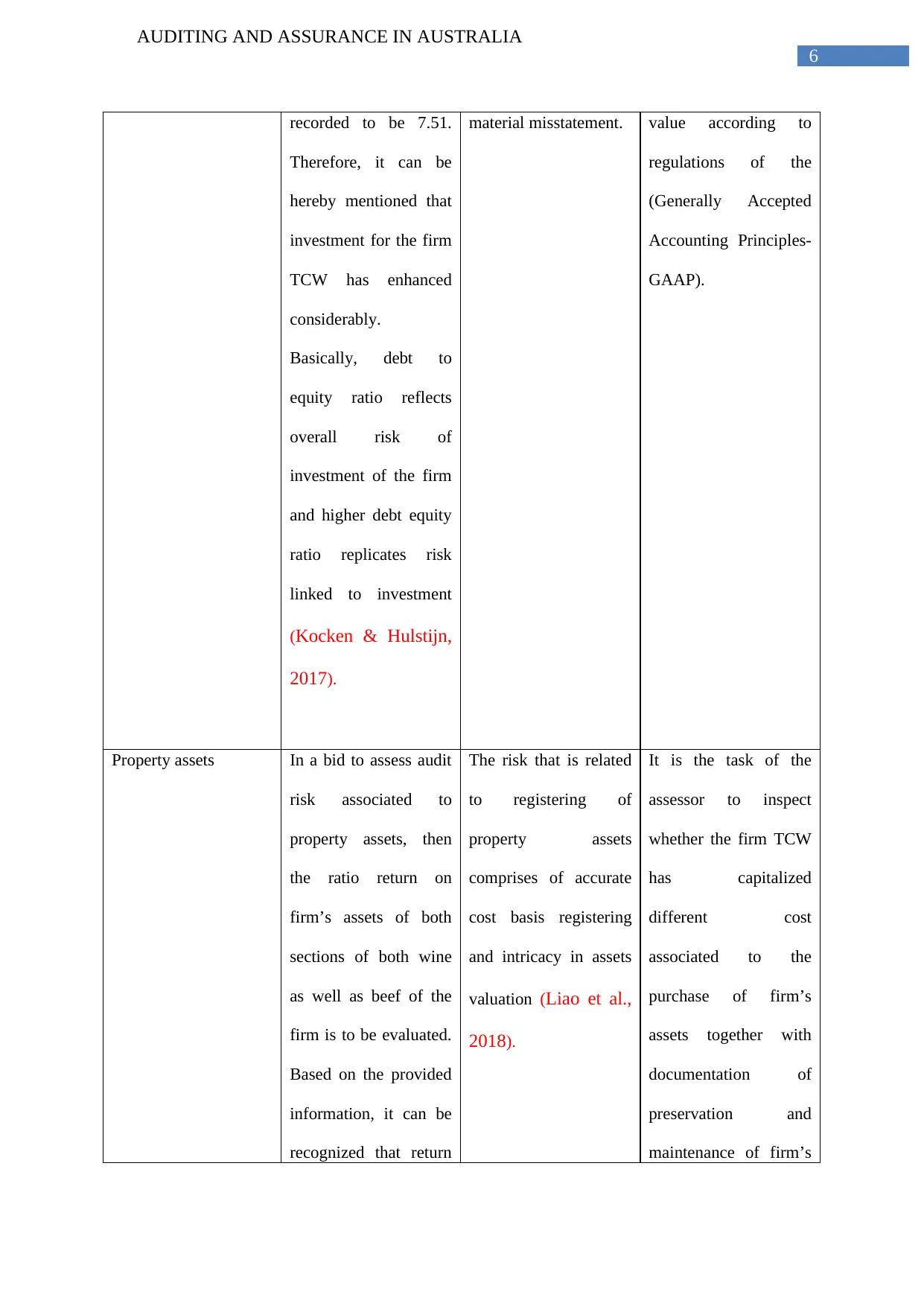
6
AUDITING AND ASSURANCE IN AUSTRALIA
recorded to be 7.51.
Therefore, it can be
hereby mentioned that
investment for the firm
TCW has enhanced
considerably.
Basically, debt to
equity ratio reflects
overall risk of
investment of the firm
and higher debt equity
ratio replicates risk
linked to investment
(Kocken & Hulstijn,
2017).
material misstatement. value according to
regulations of the
(Generally Accepted
Accounting Principles-
GAAP).
Property assets In a bid to assess audit
risk associated to
property assets, then
the ratio return on
firm’s assets of both
sections of both wine
as well as beef of the
firm is to be evaluated.
Based on the provided
information, it can be
recognized that return
The risk that is related
to registering of
property assets
comprises of accurate
cost basis registering
and intricacy in assets
valuation (Liao et al.,
2018).
It is the task of the
assessor to inspect
whether the firm TCW
has capitalized
different cost
associated to the
purchase of firm’s
assets together with
documentation of
preservation and
maintenance of firm’s
AUDITING AND ASSURANCE IN AUSTRALIA
recorded to be 7.51.
Therefore, it can be
hereby mentioned that
investment for the firm
TCW has enhanced
considerably.
Basically, debt to
equity ratio reflects
overall risk of
investment of the firm
and higher debt equity
ratio replicates risk
linked to investment
(Kocken & Hulstijn,
2017).
material misstatement. value according to
regulations of the
(Generally Accepted
Accounting Principles-
GAAP).
Property assets In a bid to assess audit
risk associated to
property assets, then
the ratio return on
firm’s assets of both
sections of both wine
as well as beef of the
firm is to be evaluated.
Based on the provided
information, it can be
recognized that return
The risk that is related
to registering of
property assets
comprises of accurate
cost basis registering
and intricacy in assets
valuation (Liao et al.,
2018).
It is the task of the
assessor to inspect
whether the firm TCW
has capitalized
different cost
associated to the
purchase of firm’s
assets together with
documentation of
preservation and
maintenance of firm’s
⊘ This is a preview!⊘
Do you want full access?
Subscribe today to unlock all pages.

Trusted by 1+ million students worldwide
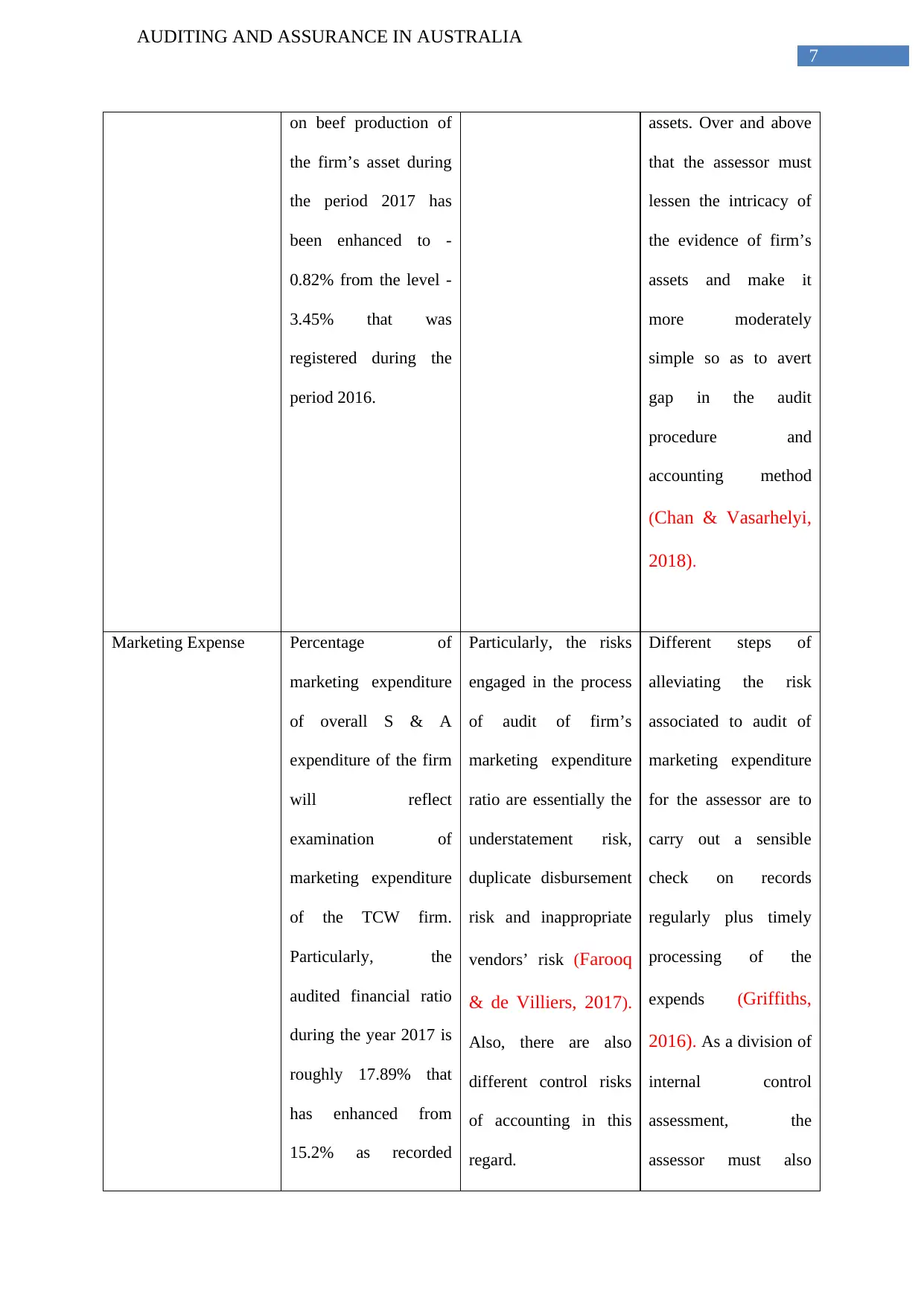
7
AUDITING AND ASSURANCE IN AUSTRALIA
on beef production of
the firm’s asset during
the period 2017 has
been enhanced to -
0.82% from the level -
3.45% that was
registered during the
period 2016.
assets. Over and above
that the assessor must
lessen the intricacy of
the evidence of firm’s
assets and make it
more moderately
simple so as to avert
gap in the audit
procedure and
accounting method
(Chan & Vasarhelyi,
2018).
Marketing Expense Percentage of
marketing expenditure
of overall S & A
expenditure of the firm
will reflect
examination of
marketing expenditure
of the TCW firm.
Particularly, the
audited financial ratio
during the year 2017 is
roughly 17.89% that
has enhanced from
15.2% as recorded
Particularly, the risks
engaged in the process
of audit of firm’s
marketing expenditure
ratio are essentially the
understatement risk,
duplicate disbursement
risk and inappropriate
vendors’ risk (Farooq
& de Villiers, 2017).
Also, there are also
different control risks
of accounting in this
regard.
Different steps of
alleviating the risk
associated to audit of
marketing expenditure
for the assessor are to
carry out a sensible
check on records
regularly plus timely
processing of the
expends (Griffiths,
2016). As a division of
internal control
assessment, the
assessor must also
AUDITING AND ASSURANCE IN AUSTRALIA
on beef production of
the firm’s asset during
the period 2017 has
been enhanced to -
0.82% from the level -
3.45% that was
registered during the
period 2016.
assets. Over and above
that the assessor must
lessen the intricacy of
the evidence of firm’s
assets and make it
more moderately
simple so as to avert
gap in the audit
procedure and
accounting method
(Chan & Vasarhelyi,
2018).
Marketing Expense Percentage of
marketing expenditure
of overall S & A
expenditure of the firm
will reflect
examination of
marketing expenditure
of the TCW firm.
Particularly, the
audited financial ratio
during the year 2017 is
roughly 17.89% that
has enhanced from
15.2% as recorded
Particularly, the risks
engaged in the process
of audit of firm’s
marketing expenditure
ratio are essentially the
understatement risk,
duplicate disbursement
risk and inappropriate
vendors’ risk (Farooq
& de Villiers, 2017).
Also, there are also
different control risks
of accounting in this
regard.
Different steps of
alleviating the risk
associated to audit of
marketing expenditure
for the assessor are to
carry out a sensible
check on records
regularly plus timely
processing of the
expends (Griffiths,
2016). As a division of
internal control
assessment, the
assessor must also
Paraphrase This Document
Need a fresh take? Get an instant paraphrase of this document with our AI Paraphraser
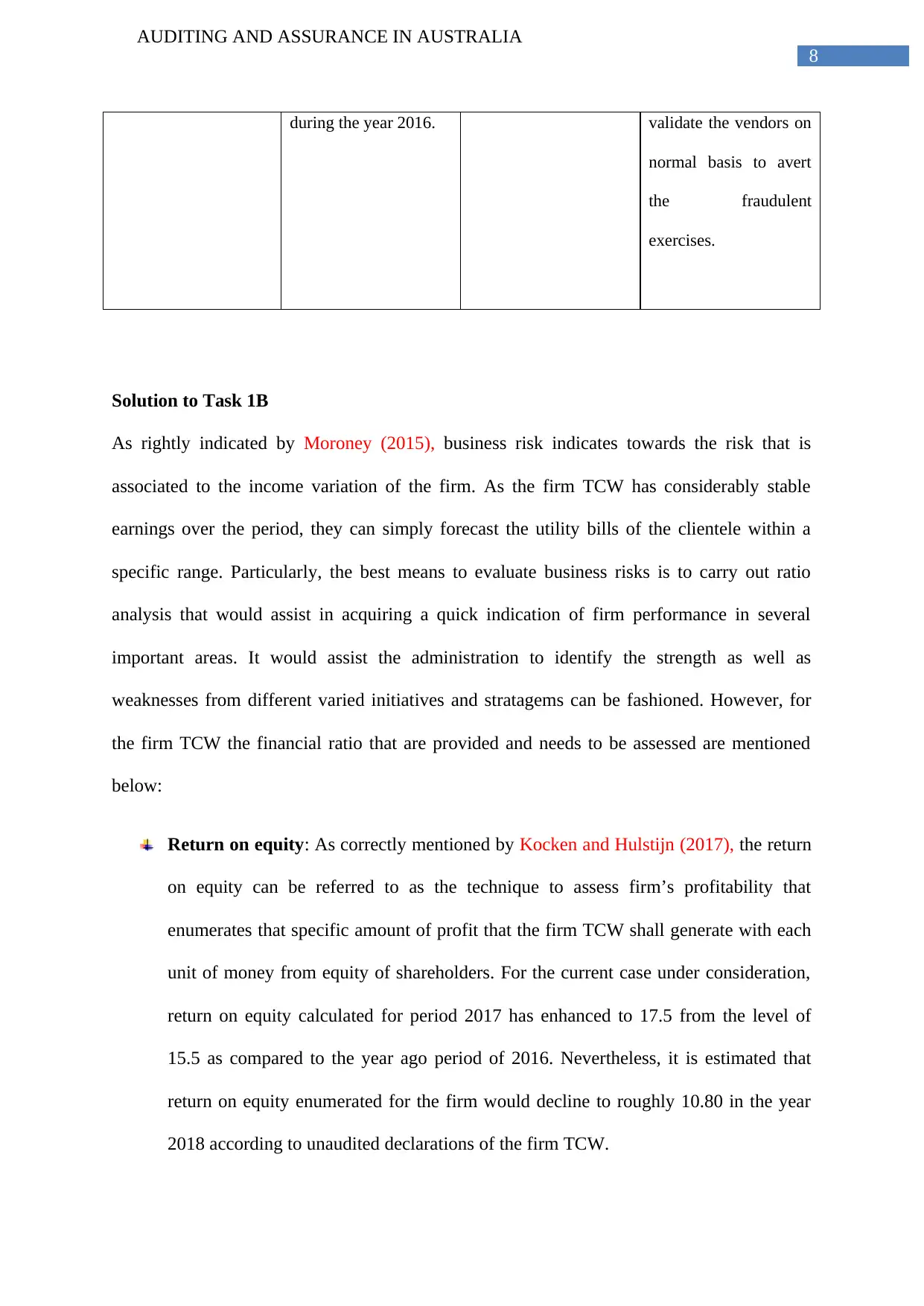
8
AUDITING AND ASSURANCE IN AUSTRALIA
during the year 2016. validate the vendors on
normal basis to avert
the fraudulent
exercises.
Solution to Task 1B
As rightly indicated by Moroney (2015), business risk indicates towards the risk that is
associated to the income variation of the firm. As the firm TCW has considerably stable
earnings over the period, they can simply forecast the utility bills of the clientele within a
specific range. Particularly, the best means to evaluate business risks is to carry out ratio
analysis that would assist in acquiring a quick indication of firm performance in several
important areas. It would assist the administration to identify the strength as well as
weaknesses from different varied initiatives and stratagems can be fashioned. However, for
the firm TCW the financial ratio that are provided and needs to be assessed are mentioned
below:
Return on equity: As correctly mentioned by Kocken and Hulstijn (2017), the return
on equity can be referred to as the technique to assess firm’s profitability that
enumerates that specific amount of profit that the firm TCW shall generate with each
unit of money from equity of shareholders. For the current case under consideration,
return on equity calculated for period 2017 has enhanced to 17.5 from the level of
15.5 as compared to the year ago period of 2016. Nevertheless, it is estimated that
return on equity enumerated for the firm would decline to roughly 10.80 in the year
2018 according to unaudited declarations of the firm TCW.
AUDITING AND ASSURANCE IN AUSTRALIA
during the year 2016. validate the vendors on
normal basis to avert
the fraudulent
exercises.
Solution to Task 1B
As rightly indicated by Moroney (2015), business risk indicates towards the risk that is
associated to the income variation of the firm. As the firm TCW has considerably stable
earnings over the period, they can simply forecast the utility bills of the clientele within a
specific range. Particularly, the best means to evaluate business risks is to carry out ratio
analysis that would assist in acquiring a quick indication of firm performance in several
important areas. It would assist the administration to identify the strength as well as
weaknesses from different varied initiatives and stratagems can be fashioned. However, for
the firm TCW the financial ratio that are provided and needs to be assessed are mentioned
below:
Return on equity: As correctly mentioned by Kocken and Hulstijn (2017), the return
on equity can be referred to as the technique to assess firm’s profitability that
enumerates that specific amount of profit that the firm TCW shall generate with each
unit of money from equity of shareholders. For the current case under consideration,
return on equity calculated for period 2017 has enhanced to 17.5 from the level of
15.5 as compared to the year ago period of 2016. Nevertheless, it is estimated that
return on equity enumerated for the firm would decline to roughly 10.80 in the year
2018 according to unaudited declarations of the firm TCW.
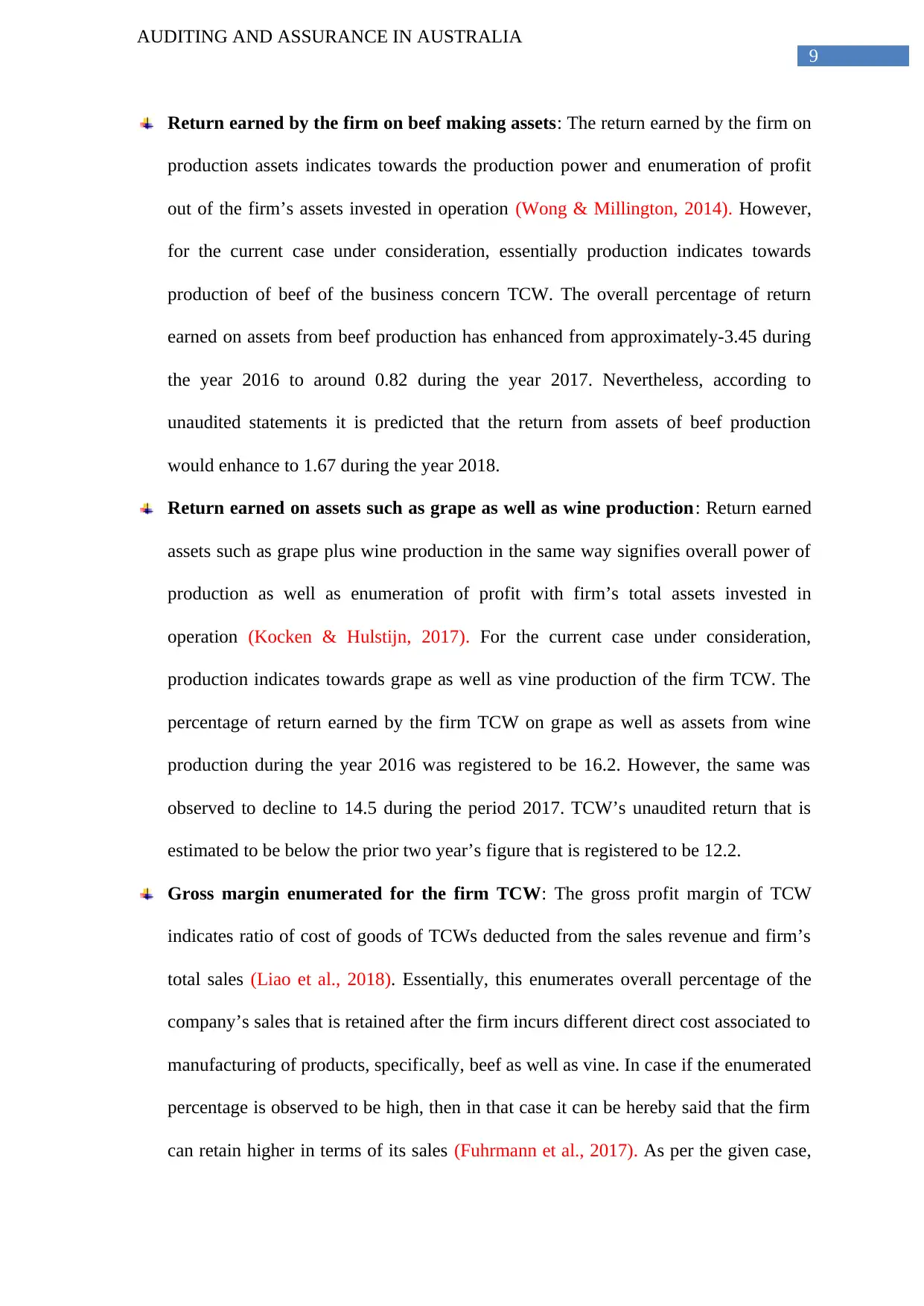
9
AUDITING AND ASSURANCE IN AUSTRALIA
Return earned by the firm on beef making assets: The return earned by the firm on
production assets indicates towards the production power and enumeration of profit
out of the firm’s assets invested in operation (Wong & Millington, 2014). However,
for the current case under consideration, essentially production indicates towards
production of beef of the business concern TCW. The overall percentage of return
earned on assets from beef production has enhanced from approximately-3.45 during
the year 2016 to around 0.82 during the year 2017. Nevertheless, according to
unaudited statements it is predicted that the return from assets of beef production
would enhance to 1.67 during the year 2018.
Return earned on assets such as grape as well as wine production: Return earned
assets such as grape plus wine production in the same way signifies overall power of
production as well as enumeration of profit with firm’s total assets invested in
operation (Kocken & Hulstijn, 2017). For the current case under consideration,
production indicates towards grape as well as vine production of the firm TCW. The
percentage of return earned by the firm TCW on grape as well as assets from wine
production during the year 2016 was registered to be 16.2. However, the same was
observed to decline to 14.5 during the period 2017. TCW’s unaudited return that is
estimated to be below the prior two year’s figure that is registered to be 12.2.
Gross margin enumerated for the firm TCW: The gross profit margin of TCW
indicates ratio of cost of goods of TCWs deducted from the sales revenue and firm’s
total sales (Liao et al., 2018). Essentially, this enumerates overall percentage of the
company’s sales that is retained after the firm incurs different direct cost associated to
manufacturing of products, specifically, beef as well as vine. In case if the enumerated
percentage is observed to be high, then in that case it can be hereby said that the firm
can retain higher in terms of its sales (Fuhrmann et al., 2017). As per the given case,
AUDITING AND ASSURANCE IN AUSTRALIA
Return earned by the firm on beef making assets: The return earned by the firm on
production assets indicates towards the production power and enumeration of profit
out of the firm’s assets invested in operation (Wong & Millington, 2014). However,
for the current case under consideration, essentially production indicates towards
production of beef of the business concern TCW. The overall percentage of return
earned on assets from beef production has enhanced from approximately-3.45 during
the year 2016 to around 0.82 during the year 2017. Nevertheless, according to
unaudited statements it is predicted that the return from assets of beef production
would enhance to 1.67 during the year 2018.
Return earned on assets such as grape as well as wine production: Return earned
assets such as grape plus wine production in the same way signifies overall power of
production as well as enumeration of profit with firm’s total assets invested in
operation (Kocken & Hulstijn, 2017). For the current case under consideration,
production indicates towards grape as well as vine production of the firm TCW. The
percentage of return earned by the firm TCW on grape as well as assets from wine
production during the year 2016 was registered to be 16.2. However, the same was
observed to decline to 14.5 during the period 2017. TCW’s unaudited return that is
estimated to be below the prior two year’s figure that is registered to be 12.2.
Gross margin enumerated for the firm TCW: The gross profit margin of TCW
indicates ratio of cost of goods of TCWs deducted from the sales revenue and firm’s
total sales (Liao et al., 2018). Essentially, this enumerates overall percentage of the
company’s sales that is retained after the firm incurs different direct cost associated to
manufacturing of products, specifically, beef as well as vine. In case if the enumerated
percentage is observed to be high, then in that case it can be hereby said that the firm
can retain higher in terms of its sales (Fuhrmann et al., 2017). As per the given case,
⊘ This is a preview!⊘
Do you want full access?
Subscribe today to unlock all pages.

Trusted by 1+ million students worldwide
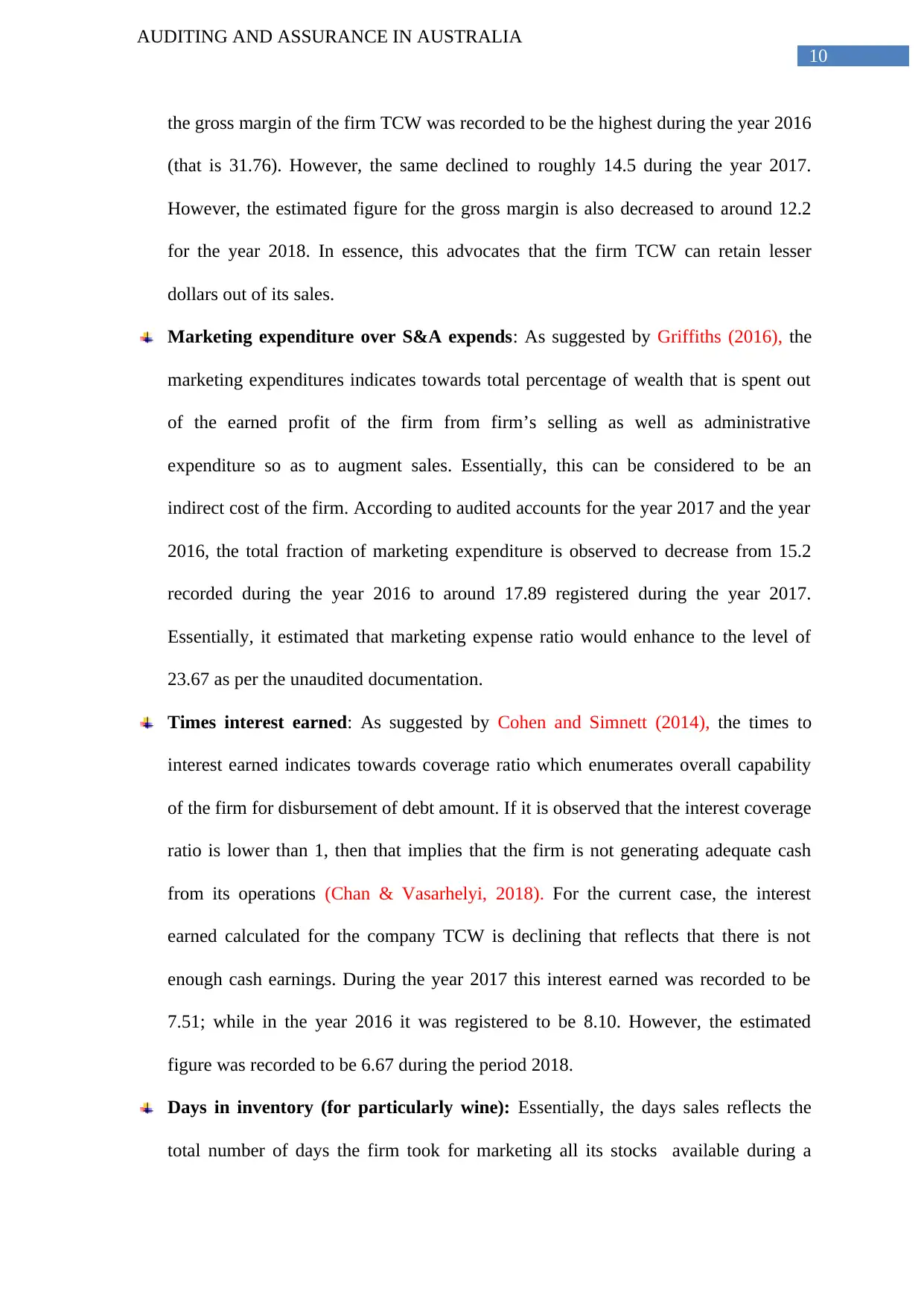
10
AUDITING AND ASSURANCE IN AUSTRALIA
the gross margin of the firm TCW was recorded to be the highest during the year 2016
(that is 31.76). However, the same declined to roughly 14.5 during the year 2017.
However, the estimated figure for the gross margin is also decreased to around 12.2
for the year 2018. In essence, this advocates that the firm TCW can retain lesser
dollars out of its sales.
Marketing expenditure over S&A expends: As suggested by Griffiths (2016), the
marketing expenditures indicates towards total percentage of wealth that is spent out
of the earned profit of the firm from firm’s selling as well as administrative
expenditure so as to augment sales. Essentially, this can be considered to be an
indirect cost of the firm. According to audited accounts for the year 2017 and the year
2016, the total fraction of marketing expenditure is observed to decrease from 15.2
recorded during the year 2016 to around 17.89 registered during the year 2017.
Essentially, it estimated that marketing expense ratio would enhance to the level of
23.67 as per the unaudited documentation.
Times interest earned: As suggested by Cohen and Simnett (2014), the times to
interest earned indicates towards coverage ratio which enumerates overall capability
of the firm for disbursement of debt amount. If it is observed that the interest coverage
ratio is lower than 1, then that implies that the firm is not generating adequate cash
from its operations (Chan & Vasarhelyi, 2018). For the current case, the interest
earned calculated for the company TCW is declining that reflects that there is not
enough cash earnings. During the year 2017 this interest earned was recorded to be
7.51; while in the year 2016 it was registered to be 8.10. However, the estimated
figure was recorded to be 6.67 during the period 2018.
Days in inventory (for particularly wine): Essentially, the days sales reflects the
total number of days the firm took for marketing all its stocks available during a
AUDITING AND ASSURANCE IN AUSTRALIA
the gross margin of the firm TCW was recorded to be the highest during the year 2016
(that is 31.76). However, the same declined to roughly 14.5 during the year 2017.
However, the estimated figure for the gross margin is also decreased to around 12.2
for the year 2018. In essence, this advocates that the firm TCW can retain lesser
dollars out of its sales.
Marketing expenditure over S&A expends: As suggested by Griffiths (2016), the
marketing expenditures indicates towards total percentage of wealth that is spent out
of the earned profit of the firm from firm’s selling as well as administrative
expenditure so as to augment sales. Essentially, this can be considered to be an
indirect cost of the firm. According to audited accounts for the year 2017 and the year
2016, the total fraction of marketing expenditure is observed to decrease from 15.2
recorded during the year 2016 to around 17.89 registered during the year 2017.
Essentially, it estimated that marketing expense ratio would enhance to the level of
23.67 as per the unaudited documentation.
Times interest earned: As suggested by Cohen and Simnett (2014), the times to
interest earned indicates towards coverage ratio which enumerates overall capability
of the firm for disbursement of debt amount. If it is observed that the interest coverage
ratio is lower than 1, then that implies that the firm is not generating adequate cash
from its operations (Chan & Vasarhelyi, 2018). For the current case, the interest
earned calculated for the company TCW is declining that reflects that there is not
enough cash earnings. During the year 2017 this interest earned was recorded to be
7.51; while in the year 2016 it was registered to be 8.10. However, the estimated
figure was recorded to be 6.67 during the period 2018.
Days in inventory (for particularly wine): Essentially, the days sales reflects the
total number of days the firm took for marketing all its stocks available during a
Paraphrase This Document
Need a fresh take? Get an instant paraphrase of this document with our AI Paraphraser
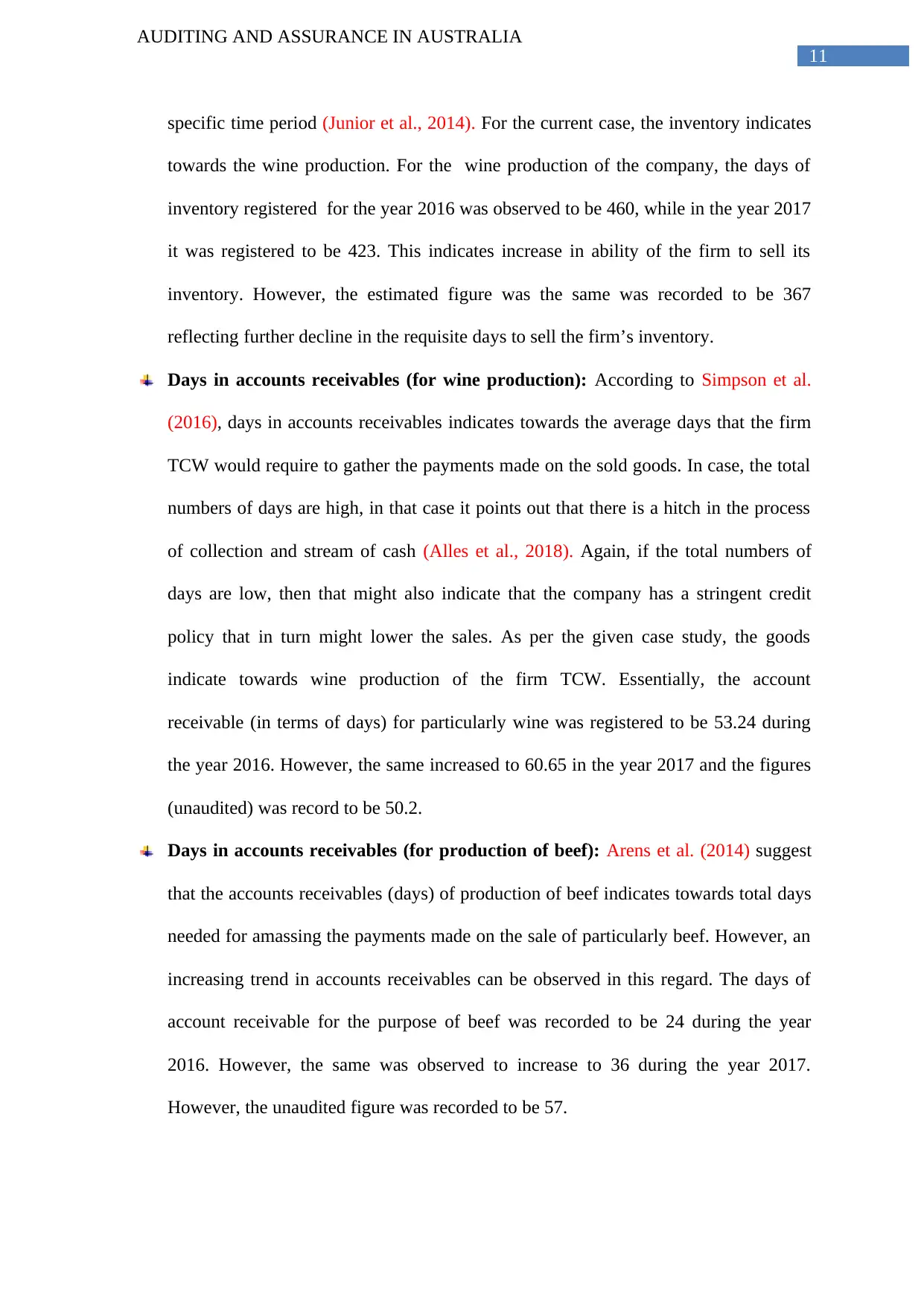
11
AUDITING AND ASSURANCE IN AUSTRALIA
specific time period (Junior et al., 2014). For the current case, the inventory indicates
towards the wine production. For the wine production of the company, the days of
inventory registered for the year 2016 was observed to be 460, while in the year 2017
it was registered to be 423. This indicates increase in ability of the firm to sell its
inventory. However, the estimated figure was the same was recorded to be 367
reflecting further decline in the requisite days to sell the firm’s inventory.
Days in accounts receivables (for wine production): According to Simpson et al.
(2016), days in accounts receivables indicates towards the average days that the firm
TCW would require to gather the payments made on the sold goods. In case, the total
numbers of days are high, in that case it points out that there is a hitch in the process
of collection and stream of cash (Alles et al., 2018). Again, if the total numbers of
days are low, then that might also indicate that the company has a stringent credit
policy that in turn might lower the sales. As per the given case study, the goods
indicate towards wine production of the firm TCW. Essentially, the account
receivable (in terms of days) for particularly wine was registered to be 53.24 during
the year 2016. However, the same increased to 60.65 in the year 2017 and the figures
(unaudited) was record to be 50.2.
Days in accounts receivables (for production of beef): Arens et al. (2014) suggest
that the accounts receivables (days) of production of beef indicates towards total days
needed for amassing the payments made on the sale of particularly beef. However, an
increasing trend in accounts receivables can be observed in this regard. The days of
account receivable for the purpose of beef was recorded to be 24 during the year
2016. However, the same was observed to increase to 36 during the year 2017.
However, the unaudited figure was recorded to be 57.
AUDITING AND ASSURANCE IN AUSTRALIA
specific time period (Junior et al., 2014). For the current case, the inventory indicates
towards the wine production. For the wine production of the company, the days of
inventory registered for the year 2016 was observed to be 460, while in the year 2017
it was registered to be 423. This indicates increase in ability of the firm to sell its
inventory. However, the estimated figure was the same was recorded to be 367
reflecting further decline in the requisite days to sell the firm’s inventory.
Days in accounts receivables (for wine production): According to Simpson et al.
(2016), days in accounts receivables indicates towards the average days that the firm
TCW would require to gather the payments made on the sold goods. In case, the total
numbers of days are high, in that case it points out that there is a hitch in the process
of collection and stream of cash (Alles et al., 2018). Again, if the total numbers of
days are low, then that might also indicate that the company has a stringent credit
policy that in turn might lower the sales. As per the given case study, the goods
indicate towards wine production of the firm TCW. Essentially, the account
receivable (in terms of days) for particularly wine was registered to be 53.24 during
the year 2016. However, the same increased to 60.65 in the year 2017 and the figures
(unaudited) was record to be 50.2.
Days in accounts receivables (for production of beef): Arens et al. (2014) suggest
that the accounts receivables (days) of production of beef indicates towards total days
needed for amassing the payments made on the sale of particularly beef. However, an
increasing trend in accounts receivables can be observed in this regard. The days of
account receivable for the purpose of beef was recorded to be 24 during the year
2016. However, the same was observed to increase to 36 during the year 2017.
However, the unaudited figure was recorded to be 57.
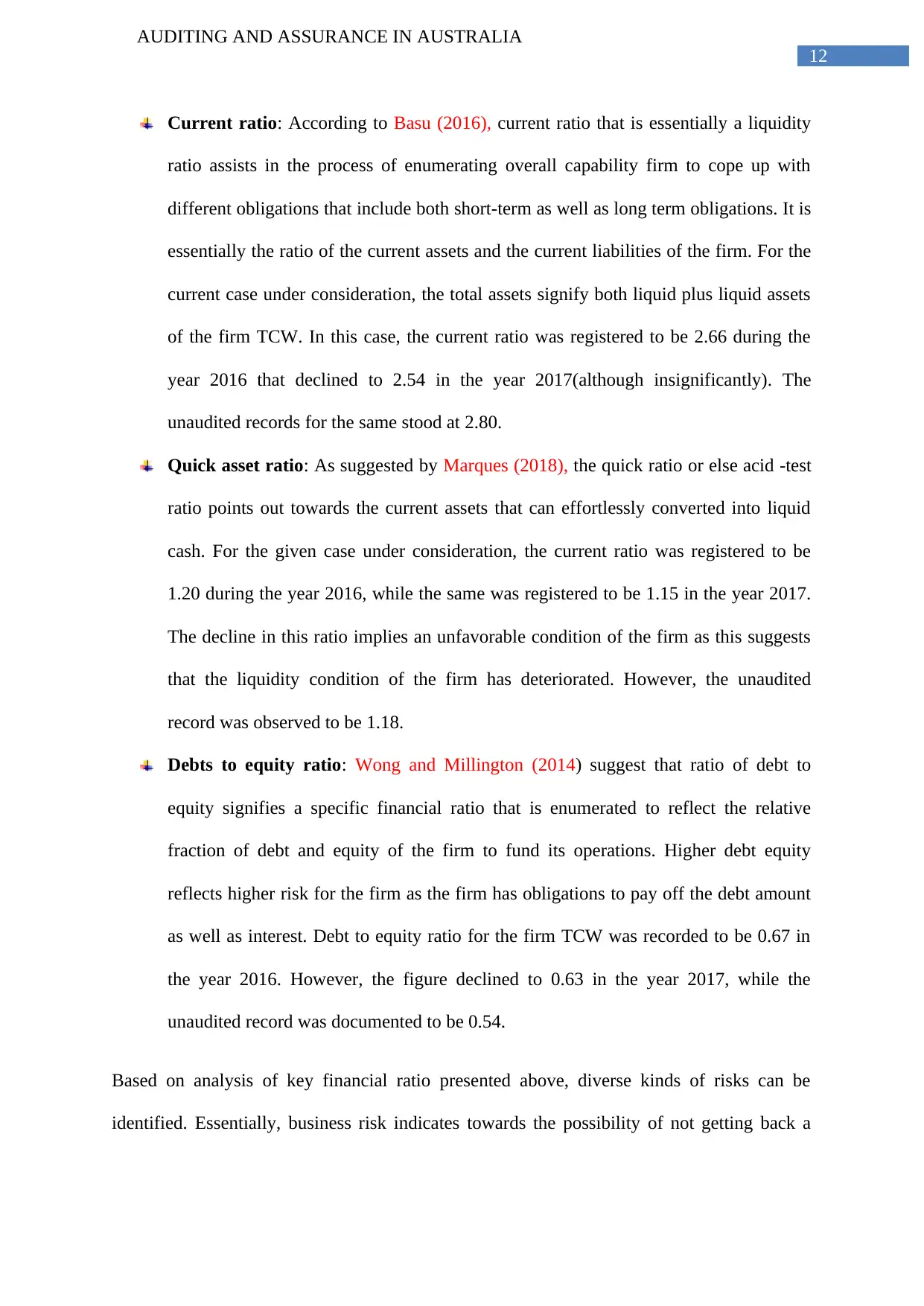
12
AUDITING AND ASSURANCE IN AUSTRALIA
Current ratio: According to Basu (2016), current ratio that is essentially a liquidity
ratio assists in the process of enumerating overall capability firm to cope up with
different obligations that include both short-term as well as long term obligations. It is
essentially the ratio of the current assets and the current liabilities of the firm. For the
current case under consideration, the total assets signify both liquid plus liquid assets
of the firm TCW. In this case, the current ratio was registered to be 2.66 during the
year 2016 that declined to 2.54 in the year 2017(although insignificantly). The
unaudited records for the same stood at 2.80.
Quick asset ratio: As suggested by Marques (2018), the quick ratio or else acid -test
ratio points out towards the current assets that can effortlessly converted into liquid
cash. For the given case under consideration, the current ratio was registered to be
1.20 during the year 2016, while the same was registered to be 1.15 in the year 2017.
The decline in this ratio implies an unfavorable condition of the firm as this suggests
that the liquidity condition of the firm has deteriorated. However, the unaudited
record was observed to be 1.18.
Debts to equity ratio: Wong and Millington (2014) suggest that ratio of debt to
equity signifies a specific financial ratio that is enumerated to reflect the relative
fraction of debt and equity of the firm to fund its operations. Higher debt equity
reflects higher risk for the firm as the firm has obligations to pay off the debt amount
as well as interest. Debt to equity ratio for the firm TCW was recorded to be 0.67 in
the year 2016. However, the figure declined to 0.63 in the year 2017, while the
unaudited record was documented to be 0.54.
Based on analysis of key financial ratio presented above, diverse kinds of risks can be
identified. Essentially, business risk indicates towards the possibility of not getting back a
AUDITING AND ASSURANCE IN AUSTRALIA
Current ratio: According to Basu (2016), current ratio that is essentially a liquidity
ratio assists in the process of enumerating overall capability firm to cope up with
different obligations that include both short-term as well as long term obligations. It is
essentially the ratio of the current assets and the current liabilities of the firm. For the
current case under consideration, the total assets signify both liquid plus liquid assets
of the firm TCW. In this case, the current ratio was registered to be 2.66 during the
year 2016 that declined to 2.54 in the year 2017(although insignificantly). The
unaudited records for the same stood at 2.80.
Quick asset ratio: As suggested by Marques (2018), the quick ratio or else acid -test
ratio points out towards the current assets that can effortlessly converted into liquid
cash. For the given case under consideration, the current ratio was registered to be
1.20 during the year 2016, while the same was registered to be 1.15 in the year 2017.
The decline in this ratio implies an unfavorable condition of the firm as this suggests
that the liquidity condition of the firm has deteriorated. However, the unaudited
record was observed to be 1.18.
Debts to equity ratio: Wong and Millington (2014) suggest that ratio of debt to
equity signifies a specific financial ratio that is enumerated to reflect the relative
fraction of debt and equity of the firm to fund its operations. Higher debt equity
reflects higher risk for the firm as the firm has obligations to pay off the debt amount
as well as interest. Debt to equity ratio for the firm TCW was recorded to be 0.67 in
the year 2016. However, the figure declined to 0.63 in the year 2017, while the
unaudited record was documented to be 0.54.
Based on analysis of key financial ratio presented above, diverse kinds of risks can be
identified. Essentially, business risk indicates towards the possibility of not getting back a
⊘ This is a preview!⊘
Do you want full access?
Subscribe today to unlock all pages.

Trusted by 1+ million students worldwide
1 out of 21
Related Documents
Your All-in-One AI-Powered Toolkit for Academic Success.
+13062052269
info@desklib.com
Available 24*7 on WhatsApp / Email
![[object Object]](/_next/static/media/star-bottom.7253800d.svg)
Unlock your academic potential
Copyright © 2020–2025 A2Z Services. All Rights Reserved. Developed and managed by ZUCOL.



